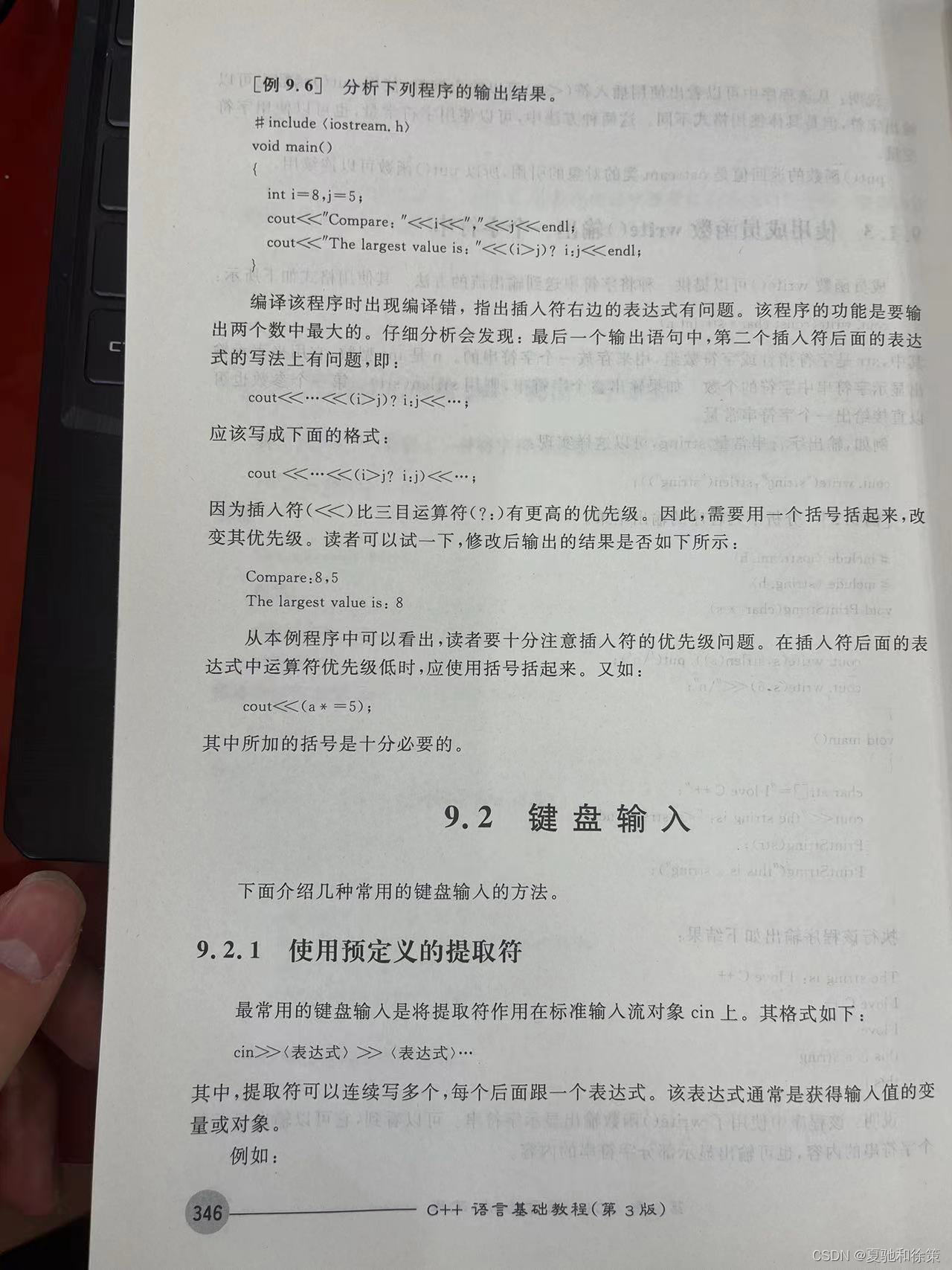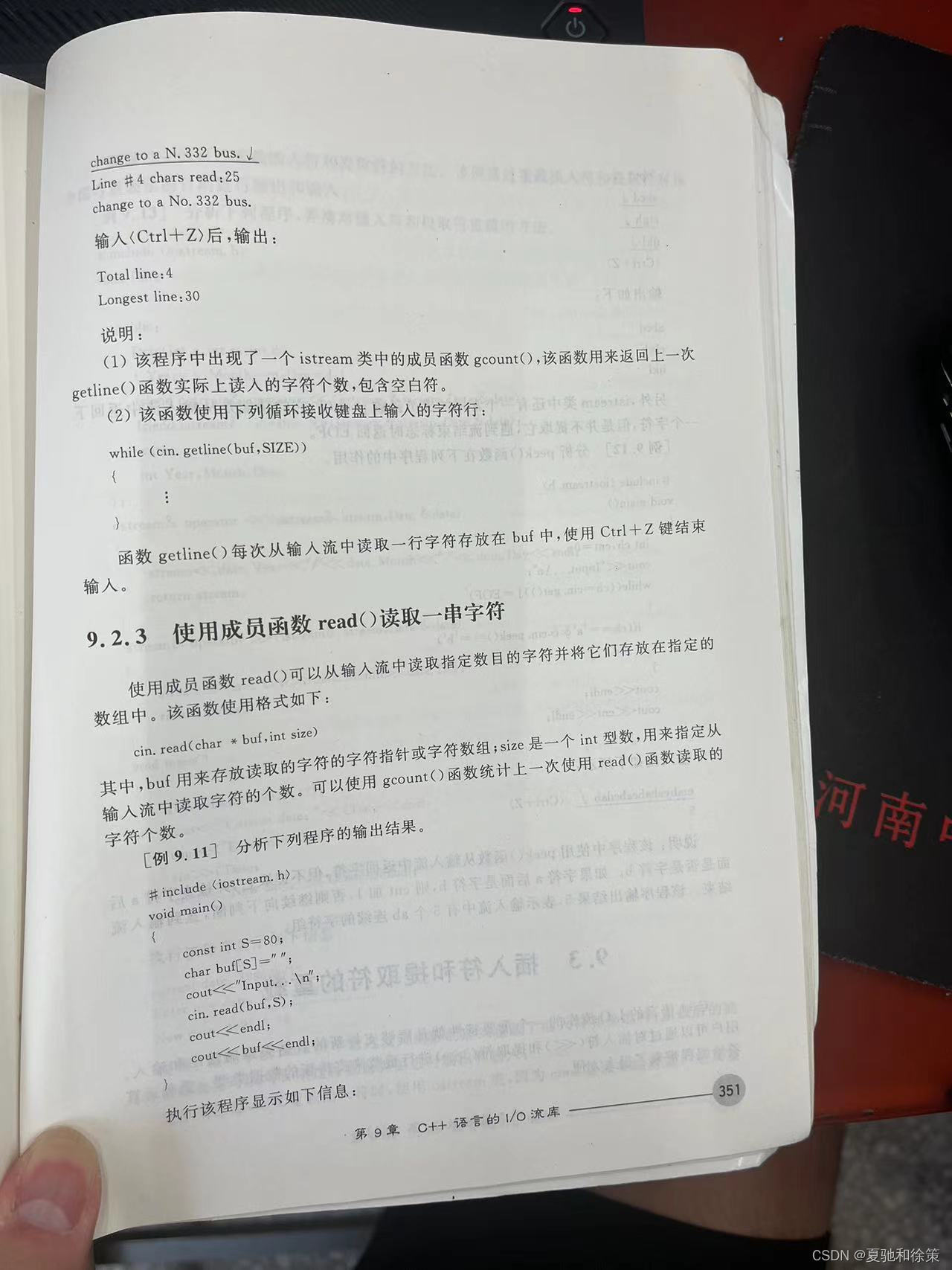

9.2 键盘输入
下面介绍几种常用的键盘输入方法。
9.2.1 使用预定义的提取符
最常用的键盘输入方法是将提取符作用在标准输入流对象 cin 上。其格式如下:
cin >> 表达式 >> 表达式 ...
提取符可以连续写多个,每个后面跟一个表达式,通常是获得输入值的变量或对象。
示例:使用预定义的提取符进行键盘输入
#include <iostream>
using namespace std;
int main() {
int a, b;
cout << "Please enter two integers: ";
cin >> a >> b;
cout << "(" << a << ", " << b << ")" << endl;
return 0;
}
输出结果:
Please enter two integers: 5 6
(5, 6)
在这个例子中,用户输入两个整数 5 和 6,程序将它们分别存储在变量 a 和 b 中,并输出。
9.2.2 使用成员函数 get() 获取一个字符
get() 函数可以从输入流获取一个字符,并将其存放在指定变量中。
示例:使用 get() 获取字符
#include <iostream>
using namespace std;
int main() {
char ch;
cout << "Input: ";
while ((ch = cin.get()) != EOF) {
cout.put(ch);
}
cout << "ok!";
return 0;
}
输出结果:
abcu xyz
123
ok!
9.2.3 使用成员函数 getline() 读取一行字符
getline() 函数用于从输入流中读取一行字符。
示例:使用 getline() 读取一行字符
#include <iostream>
using namespace std;
const int SIZE = 80;
int main() {
int lcnt = 0, lmax = -1;
char buf[SIZE];
cout << "Input...\n";
while (cin.getline(buf, SIZE)) {
int count = cin.gcount();
lcnt++;
if (count > lmax) lmax = count;
cout << "Line #" << lcnt << "\t" << "chars read: " << count << endl;
cout.write(buf, count).put('\n').put('\n');
}
cout << endl;
cout << "Total lines: " << lcnt << endl;
cout << "Longest line: " << lmax << endl;
return 0;
}
输出结果:
Input...
this is a string.
Line #1 chars read: 18
this is a string.
you are a student.
Line #2 chars read: 19
you are a student.
the four seasons of the year.
Line #3 chars read: 30
the four seasons of the year.
change to a No.332 bus.
Line #4 chars read: 25
change to a No.332 bus.
Total lines: 4
Longest line: 30
在这个例子中,getline() 函数从输入流中逐行读取字符,并统计每行的字符数。最后输出输入的总行数和最长行的字符数。
9.2.4 使用成员函数 read() 读取一串字符
read() 函数用于从输入流中读取指定数目的字符,并将它们存放在指定的数组中。
示例:使用 read() 读取一串字符
#include <iostream>
using namespace std;
int main() {
const int S = 80;
char buf[S] = "";
cout << "Input...\n";
cin.read(buf, S);
cout << endl;
cout << buf << endl;
return 0;
}
输出结果:
Input...
abcd
efgh
ijkl
abcd
efgh
ijkl
在这个例子中,read() 函数从输入流中读取指定数量的字符并存储在 buf 数组中,然后输出该数组的内容。
9.2.5 使用成员函数 peek() 返回下一个字符
peek() 函数从输入流中返回下一个字符,但不提取它。
示例:使用 peek() 返回下一个字符
#include <iostream>
using namespace std;
int main() {
int ch, cnt = 0;
cout << "Input...\n";
while ((ch = cin.get()) != EOF) {
if (ch == 'a' && cin.peek() == 'b')
cnt++;
}
cout << endl;
cout << cnt << endl;
return 0;
}
输入:
mabyababcabcdab
Ctrl+Z
输出结果:
5
在这个例子中,peek() 函数检查字符 a 后面是否是字符 b,如果是则计数器 cnt 加1。程序最后输出字符串中包含的 ab 子串的数量。
结论
C++ I/O流库提供了多种方法来处理键盘输入,通过使用预定义的提取符、get()、getline()、read() 和 peek() 等成员函数,可以灵活地读取用户输入的数据。这些功能使得C++程序能够高效地与用户交互,为开发提供了极大的便利。希望本文对C++ I/O流库中键盘输入方法的理解有所帮助,为编写更灵活、更易维护的C++程序提供支持。

































 被折叠的 条评论
为什么被折叠?
被折叠的 条评论
为什么被折叠?










